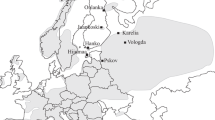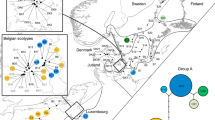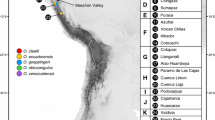Abstract
To characterize the genetic diversity of present populations of Symplocos laurina, which grow in the montane forests in India, we analyzed the DNA sequences of a nuclear gene. Using the 881 bp sequence of cytosolic Glyceraldehyde-3-phosphate dehydrogenase gene, we detected 24 haplotypes among 195 individuals sampled from 14 populations. Two dominant haplotypes were distributed over the entire range of this species in India and several private haplotypes were found. Low genetic diversity within population, high differentiation, number of population specific haplotypes and deviation from neutral evolution characterized the present populations of S. laurina. An analysis of molecular variance indicated the presence of geographic structure within the haplotype distribution. The occurrence of S. laurina preglaciation in India is the most parsimonious explanation for the current geographic structure observed. The populations are presumably ancient and might have spread across its extant distribution range in India through a recent range expansion event.




Similar content being viewed by others
References
Abbott RJ, Gomes MF (1989) Population structure and outcrossing rate of Arabidopsis thaliana (L.) Heynh. Heredity 62:411–418
Almeida SM (1990) The Flora of Savantwadi, Maharashtra, India, vol. 1. Scientific Publishers, Jodhpur, India
Avise JC (2000) Phylogeography: the history and formation of species. Harvard University Press, London
Bandelt HJ, Forster P, Röhl A (1999) Median-joining networks for inferring intraspecific phylogenies. Mol Biol Evol 16:37–48
Bonnet E, Van dePeer Y (2002) zt: a software tool for simple and partial Mantel tests. J Stat Soft 7:1–12
Braverman J, Hudson R, Kaplan N et al (1995) The hitchhiking effect on the site frequency spectrum of DNA polymorphisms. Genetics 140:783–796
Caicedo AL, Schaal BA (2004) Population structure and phylogeography of Solanum pimpinellifolium inferred from a nuclear gene. Mol Ecol 13:1871–1882
Charlesworth B, Morgan MT, Charlesworth D (1993) The effect of deleterious mutations on neutral molecular variation. Genetics 134:1289–1303
Cheng YP, Hwang SY, Lin TP (2005) Two potential refugia in Taiwan revealed by the phylogeographical study of Castanopsis carlesii Hayata (Fagaceae). Mol Ecol 14:2075–2085
Chung JD, Lin TP, Tan YC et al (2004) Genetic diversity and biogeography of Cunninghamia konishii (Cupressaceae), an island species in Taiwan: a comparison with Cunninghamia lanceolata, a mainland species in China. Mol Phylogenet Evol 33:791–801
Dane F, Liu J, Zhang C (2007) Phylogeography of the bitter apple, Citrullus colocynthis. Genet Resour Crop Ev 54:327–336
Deshpande AU, Apte GS, Bahulikar RA et al. (2001) Genetic diversity across natural populations of three montane plant species from the Western Ghats, India revealed by intersimple sequence repeats. Mol Ecol 10:2397–2408
Dynesius M, Jansson R (2000) Evolutionary consequences of changes in species’ geographical distributions driven by Milankovitch climate oscillations. Proc Natl Acad Sci USA 97:9115–9120
Ellstrand NC, Prentice H, Hancock JF (1999) Geneflow and introgression from domesticated plants into their wild relatives. Ann Rev Ecol Syst 30:539–563
Excoffier L, Smouse PE, Quattro JM (2005) Analysis of molecular variance inferred from metric distances among DNA haplotypes: application to human mitochondrial DNA restriction data. Genetics 131:479–491
Fu YX, Li WH (1993) Statistical tests of neutrality of mutations. Genetics 133:693–709
Gaskin JF, Schaal BA (2002) Hybrid Tamarix widespread in US invasion and undetected in native Asian range. Proc Natl Acad Sci USA 99:11256–11259
Gaut BS (1998) Molecular clocks and nucleotide substitution rates in higher plants. Evol Biol 30:93–120
Grant PR, Grant BR (1997) Genetics and origin of bird species. Proc Natl Acad Sci USA 94:7768–7775
Griffin SR, Barrett SCH (2004) Post-glacial history of Trillium grandiflorum (Melanthiaceae) in eastern North America: inferences from phylogeography. Am J Bot 91:465–473
Hare MP (2001) Prospects for nuclear gene phylogeography. Trends Ecol Evol 16:700–706
Harpending H (1994) Signature of ancient population growth in a low resolution mitochondrial DNA mismatch distribution. Hum Bio 66:591–600
Hewitt G (2000) The genetic legacy of the Quaternary ice ages. Nature 405:907–913
Holderegger R, Stehlik I, Abbott RJ (2002) Molecular analysis of the Pleistocene history of Saxifraga oppositifolia in the Alps. Mol Ecol 11:1409–1418
Hudson RR, Kaplan NL (1985) Statistical properties of the number of recombination events in the history of a sample of DNA sequences. Genetics 111:147–164
Johannesen J, Lubin Y, Laufs T et al (2005) Dispersal history of a spider (Stegodyphus lineatus) across contiguous deserts: vicariance and range expansion. Biol J Linnean Soc 84:39–754
Johnson KP, Adler FR, Cherry JL (2000) Genetic and phylogenetic consequences of island biogeography. Evolution 54:387–396
Jordan WC, Courtney MW, Neigel JE (1997) Low levels of infraspecific genetic variation at a rapidly evolving chloroplast DNA locus in North American duckweeds (Lemnaceae). Am J Bot 83:430–439
Jukes TH, Cantor CR (1969) Evolution of protein molecules. In: Munro HN (ed) Mammalian Protein Metabolism. Academic Press, New York, pp 21–132
Koehler-Santos P, Lorenz-Lemke AP, Salzano FM et al (2006) Ecological-evolutionary relationships in Passiflora alata from Rio Grande do Sul, Brazil. Braz J Biol 66:809–816
Kreitman M (2000) Methods to detect selection in populations with applications to the human. Annu Rev Genomics Hum Genet 1:539–559
Kuittinen H, Mattila A, Savolainen O (1997) Genetic variation at marker loci and in quantitative traits in natural populations of Arabidopsis thaliana. Heredity 79:144–152
Li WC (1998) The Chinese Quaternary Vegetation and Environment. Science Press, Beijing
Meher-Homji VM (1967) Phytogeography of the South Indian hill stations. Bull Torrey Bot Club 94:232–240
Meher-Homji VM (1972) Himalayan plants on South Indian Hills: role of Pleistocene glaciation vs long distance dispersal. Sci Cult 38:8–12
Meher-Homji VM (1975) On the montane species of Kodaikanal, South India. Phytocoenologia 2:28–39
Morrell PL, Lundy KE, Clegg MT (2003) Distinct geographic patterns of genetic diversity are maintained in wild barley (Hordeum vulgare ssp. spontaneum) despite migration. Proc Natl Acad Sci USA 100:10812–10817
Nei M (1987) Molecular Evolutionary Genetics. Columbia University Press, New York
Ohta T (2002) Near-neutrality in evolution of genes and gene regulation. Proc Natl Acad Sci USA 99:16134–16137
Olsen KM (2002) Population history of Manihot esculenta (Euphorbiaceae) inferred from nuclear DNA sequences. Mol Ecol 11:901–911
Olsen KM, Schaal BA (1999) Evidence on the origin of cassava: phylogeography of Manihot esculenta. Proc Natl Acad Sci USA 96:5586–5591
Pérusse JR, Schoen DJ (2004) Molecular evolution of the GapC gene family in Amsinckia spectabilis populations that differ in outcrossing rate. J Mol Evol 59:427–436
Pons O, Petit RJ (1996) Measuring and testing genetic differentiation with ordered versus unordered alleles. Genetics 144:1237–1245
Ramos-Onsins SE, Rozas J (2002) Statistical properties of new neutrality tests against population growth. Mol Biol Evol 19:2092–2100
Rand DM (1996) Neutrality tests of molecular markers and the connection between DNA polymorphism, demography and conservation biology. Conserv Biol 10:665–671
Richards E, Reichardt M, Rogers S (1994) Preparation of genomic DNA from plant tissues. In: Ausubel EM (ed) Current Protocols in Molecular Biology. John Wiley and Sons, New York, pp 2.3.1–2.3.7
Riddle BR (1996) The molecular phylogeographic bridge between deep and shallow history in continental biotas. Trends Ecol Evol 11:207–211
Rogers AR, Harpending HC (1992) Population growth makes waves in the distribution of pairwise genetic differences. Mol Biol Evol 9:552–569
Rozas J, Rozas R (1997) DNASP, version 2.0: a novel software package for extensive molecular population genetic analysis. Computer Applied Biosciences 13:307–311
Rozas J, Sanchez-Delbarrio JC, Messeguer X et al (2003) DnaSP, DNA polymorphism analyses by the coalescent and other methods. Bioinformatics 19:2496–2497
Schaal BA, Olsen KM (2000) Gene genealogies and population variation in plants. Proc Natl Acad Sci USA 97:7024–7029
Schaal BA, Hayworth DA, Olsen KM et al (1998) Phylogeographic studies in plants: problems and prospects. Mol Ecol 7:465–474
Schierup MH, Hein J (2000) Consequences of recombination on traditional phylogenetic analysis. Genetics 156:879–891
Shih FL, Hwang SY, Cheng YP et al (2007) Uniform genetic diversity, low differentiation, and neutral evolution characterize contemporary refuge populations of Taiwan fir (Abies Kawakamii, Pinaceae). Am J Bot 94:194–202
Smith JM, Haigh J (1974) The hitch-hiking effect of a favourable gene. Genet Res 23:23–35
Strand AE, Leebens-Mack J, Milligan BG (1997) Nuclear DNA based markers for plant evolutionary biology. Mol Ecol 6:113–118
Tajima F (1989) Statistical method for testing the neutral mutation hypothesis by DNA polymorphism. Genet 123:585–595
Tani N, Tsumura NY, Sato H (2003) Nuclear gene sequences and DNA variation of Cryptomeria japonica samples from postglacial period. Mol Ecol 12:859–868
Thompson JD, Gibson TJ, Plewniak F, Jeanmougin F, Higgins DG (1997) The ClustalX windows interface: flexible strategies for multiple sequence alignment aided by quality analysis tools. Nucl Acids Res 25:4876–4882
Todokoro S, Terauchi R, Kawano S (1995) Microsatellite polymorphisms in natural populations of Arabidopsis thaliana in Japan. Jap J Genet 70:543–554
Van Rossum F, Bonnin I, Fenart S, Pauwels M, Petit D, Saumitou-Laprade P (2004) Spatial genetic structure within a metallicolous population of Arabidopsis halleri, a clonal, self incompatible and heavy metal tolerant species. Mol Ecol 13:2959–2967
Wolfe KH, Li WH, Sharp PM (1987) Rates of nucleotide substitution vary greatly among plant mitochondria, chloroplast, and nuclear DNAs. Proc Natl Acad Sci USA 84:9054–9058
Wright S (1931) Evolution in Mendelian populations. Genetics 16:97–159
Wu SH, Hwang CY, Lin TP et al (2006) Contrasting phylogeographic patterns of two closely related species, Machilus thunbergii and Machilus kusanoi (Lauraceae), in Taiwan. J Biogeogr 33:936–947
Zhang DX, Hewitt GM (2003) Nuclear DNA analyses in genetic studies of populations: practice, problems and prospects. Mol Ecol 12:563–584
Acknowledgments
The authors thank Ram Kulkarni from National Chemical Laboratory, Dr. B G Kulkarni and Dr. P S N Rao from Botanical Survey of India, Western Circle, Pune and H S Suresh (Center for Ecological Science, Indian Institute of Science, Bangalore) for the help rendered during sampling. Authors will like to thank Dr. Abhay Harsulkar and Rupali Khadke (Interactive Research School of Health Affairs, Pune) for their help in designing the experiments. We also thank the staff at various field stations and Forest Departments for their co-operation in sampling. We thank Dr. Rebecca Zwart from the National Chemical Laboratory, for her help in refining the manuscript. SB thanks the Council of Scientific and Industrial Research (CSIR), New Delhi for her research fellowship. This project was supported by a grant from the Department of Biotechnology, New Delhi to NCL and BSI.
Author information
Authors and Affiliations
Corresponding author
Rights and permissions
About this article
Cite this article
Banu, S., Bhagwat, R.M., Kadoo, N.Y. et al. Understanding the genetic structure of Symplocos laurina Wall. Populations using nuclear gene markers. Genetica 138, 197–210 (2010). https://doi.org/10.1007/s10709-009-9410-y
Received:
Accepted:
Published:
Issue Date:
DOI: https://doi.org/10.1007/s10709-009-9410-y




